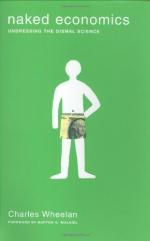
|
| Name: _________________________ | Period: ___________________ |
This test consists of 15 multiple choice questions and 5 short answer questions.
Multiple Choice Questions
1. According to the author in Chapter 3, it's up to whom to consider the broad social consequences of decisions In a market economy?
(a) Nonprofit organizations.
(b) Corporations.
(c) Religious institutions.
(d) The government.
2. What term was first used in the early 1990s to denote an organization's reputation as an employer?
(a) Employer branding.
(b) The Juche Idea.
(c) Futures contract.
(d) Trade-off.
3. According to the author, financial markets boil down to four basic simple needs. What is the second discussed in Chapter 7?
(a) Speculation.
(b) Storing, protecting and making profitable use of excess capital.
(c) Insuring against risk.
(d) Raising capital.
4. According to Burton G. Malkiel in the Forward, economists often don't show a connection to what?
(a) Everyday life.
(b) Wall Street.
(c) Statistics.
(d) Mathematics.
5. In an insurance policy, what is the amount of expenses that must be paid out of pocket before an insurer will pay any expenses?
(a) Deductible.
(b) Collateral.
(c) Inflation.
(d) Subsidy.
6. Gary Becker was awarded the Nobel Memorial Prize in Economic Sciences in what year?
(a) 2003.
(b) 1992.
(c) 1997.
(d) 1988.
7. Who introduced the Hope credit?
(a) John F. Kennedy.
(b) Bill Clinton.
(c) Ronald Reagan.
(d) George W. Bush.
8. What contends that prices of publicly traded assets reflect all publicly available information?
(a) Supply and demand.
(b) The efficient market hypothesis.
(c) Adverse selection.
(d) The uniform pay scale.
9. What is a fee paid by a borrower of assets to the owner as a form of compensation for the use of the assets?
(a) Deductible.
(b) Interest.
(c) Subsidy.
(d) Derivative.
10. Economists ignored signs of problems in what year because they didn't want to face what might happen in the future, according to the author in the Introduction?
(a) 2002.
(b) 1994.
(c) 1998.
(d) 2005.
11. What does CEO stand for?
(a) Civil Engineer's Office.
(b) Chief Executive Officer.
(c) Cheap Everpresent Oil.
(d) Continental Energy Options.
12. What describes the extent to which time or effort is well used for the intended task or purpose?
(a) Efficiency.
(b) Intention.
(c) Reliability.
(d) Proximity.
13. With uniform rules and regulations, the cost of doing business in the private sector is what, according to the author in Chapter 3?
(a) Lowered.
(b) Prohibitive.
(c) Maintained.
(d) Raised.
14. Human capital is extremely important in economics because it is also tied together with what?
(a) Collateral.
(b) Inflation.
(c) Productivity.
(d) Security.
15. What are negative results which occur while trying to achieve a goal for the common good?
(a) Ghost incentives.
(b) Perverse incentives.
(c) Abstract incentives.
(d) Unknown incentives.
Short Answer Questions
1. In finance, what is a debt security in which the authorized issuer owes the holders a debt and, depending on the terms, is obliged to pay interest to use and/or to repay the principal at a later date?
2. In finance, what is a derivative financial instrument that specifies a contract between two parties for a future transaction on an asset at a reference price?
3. When did Ross Perot found Electronic Data Systems?
4. What is the financial system consisting of institutions and regulators that act on the international level, as opposed to those that act on a national or regional level?
5. In what year did the French government try to address its unemployment rates with what the author calls the economic equivalent of fool's gold?
|
This section contains 502 words (approx. 2 pages at 300 words per page) |

|




